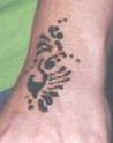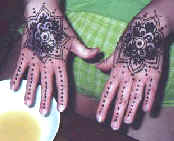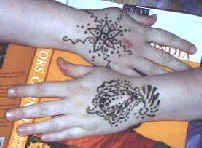|
the Indian Party the Mehndi party |
|
| A week before the actual party we had a Mehndi party hosted by and under the guidance of Karen McFerran (the only one of us who has actually done a lot of this before). |
|
the Indian Party the Mehndi party |
|
| A week before the actual party we had a Mehndi party hosted by and under the guidance of Karen McFerran (the only one of us who has actually done a lot of this before). |
|
|
Most of the participants were female, although we told the guys they were welcome. We spent a pleasant afternoon applying the paste and letting it set while we gossiped, snacked, and listened to soothing music; much like we envisioned Indian women doing in the heat of the Sub-Continent. |
Mehndi; an Ancient Art of Body Decoration by Karen McFerran (copyright 2000) |
|
| Henna has been used
throughout North Africa, Southeast Asia, India, and Pakistan for
thousands of years for adornment, ritual, and health. Henna was probably
first used as a cooling paste applied to hands and feet. As its use
continued, the application evolved from covering the whole hand or foot
to applying an intricate design to the hands.
The designs greatly vary, depending on the region and the reason for application. A design used on an Indian bride might be completely inappropriate for a Muslim woman from Egypt. Mehndi recipes are as varied as the designs. The one I use is a combination of several recipes I have come across and tested over the past year. I found that it gave the best color and logevity results. I have included a list of ingredients that go into the henna paste. If you are allergic or think you might be allergic to any of these items and are attending the henna party please let me know so I can adapt a recipe for you. The ingredients are as follows: black tea, instant coffee, tamarind paste, cloves, henna, eucalyptus oil, olive oil, lemon juice, and sugar. I will be preparing the henna paste ahead of time due to the fermentation that needs to occur. The ingredients must set for at least twelve hours in two of the steps. There are shorter duration recipes, but as I said earlier, I prefer this one. The first step is sifting the henna powder. This is important because there are twigs and other debris found in henna powder in addition to the clumps that form during storage or exposure to moisture. The finer the powder, the thinner a line you will be able to achieve with the finished powder. The debris will also clog the tip of the cone or applicator bottle. The second step involves making very strong tea (overnight steeping) and mixing in instant coffee, tamarind paste. and cloves. To this mixture the henna powder is added a little at a time till the mixture reaches the consistency of toothpaste. After the paste is made, you add the 6 drops of eucalyptus oil. The paste then ferments for 12 hours. While the henna paste ferments, you can prepare the application cones and setting solution (or just sleep). The application cones are made from heavy plastic (drop cloth weight) and sealed with tape. The setting solution is lemon juice and sugar. So, you may be asking yourself, what do I need to do before the mendhi party and what should I bring. Well, these are both very good questions. I wish I had answers. Just kidding. Any area you want to have a design on should be cleaned (shaved and exfoliated) 24 hours ahead of time. Do not apply lotions or oils to the area if at all possible. What to bring? |
|
|
the Results: |
 Nora's arm |
 Ramona's hands |
|
|
 Nora's hand |
 Karen H's hands |
| Frequently asked questions | |
| 1. How can I remove a
design? There is no quick way to remove a design. However you can
shorten the length of time the design is visible by a) daily vigorously
scrubbing, b) using suntan lotion, c) swimming in chlorinated water, d)
washing dishes with bare hands. Once the design has nearly faded
completely, you can remove the remnants of the design by rubbing the
area with a cotton ball soaked in hydrogen peroxide.
2. How long will the design last? A design may last up to a month, but the average design will last from about one to three weeks. The length of time is dependent on the area of the body, how much the area is exposed to water, soap, rubbing, or chemicals, and the person's lifestyle. The color and depth of stain are dependent on the skin texture and temperature of the area, protection of the paste during the drying process and how long the paste is left on the skin. The design will last longer and be darker on a warmer body part like the palms or soles of the feet. However the palms and sole are frequently used body surfaces and that shortens the life of the design. Areas where frequent exfoliation occurs and where the skin is thin like the face and chest are poor choices for a lasting design. 3. What color will the design be after the paste is removed? The color will vary from light orange to dark reddish brown, depending on the individual's skin, the type of henna, and the catalyst. 4. Does henna come in colors? No. There are many sources that sell black and colored henna. Black and other colors are the result of added dyes. |
|
| Back to Main | |